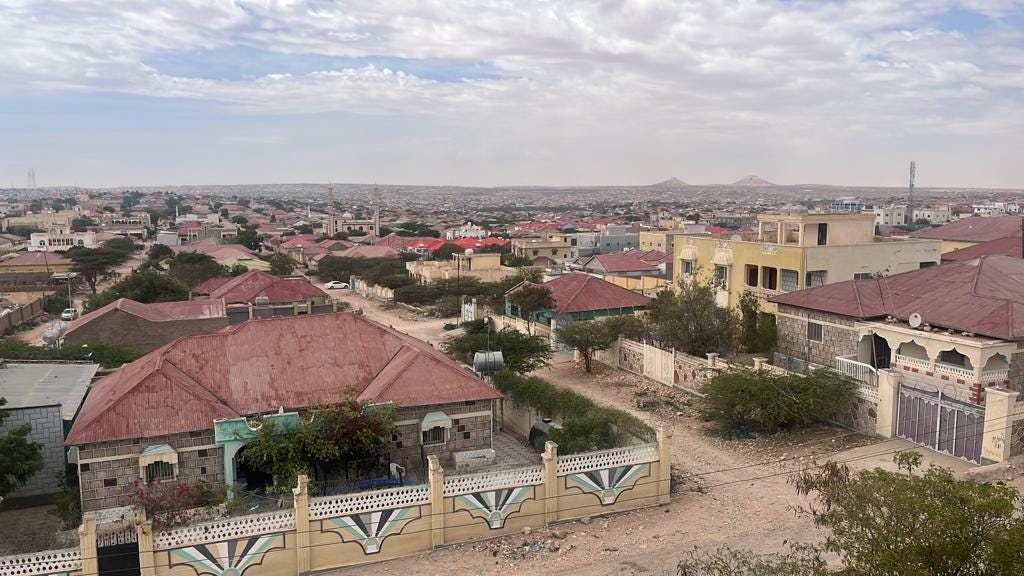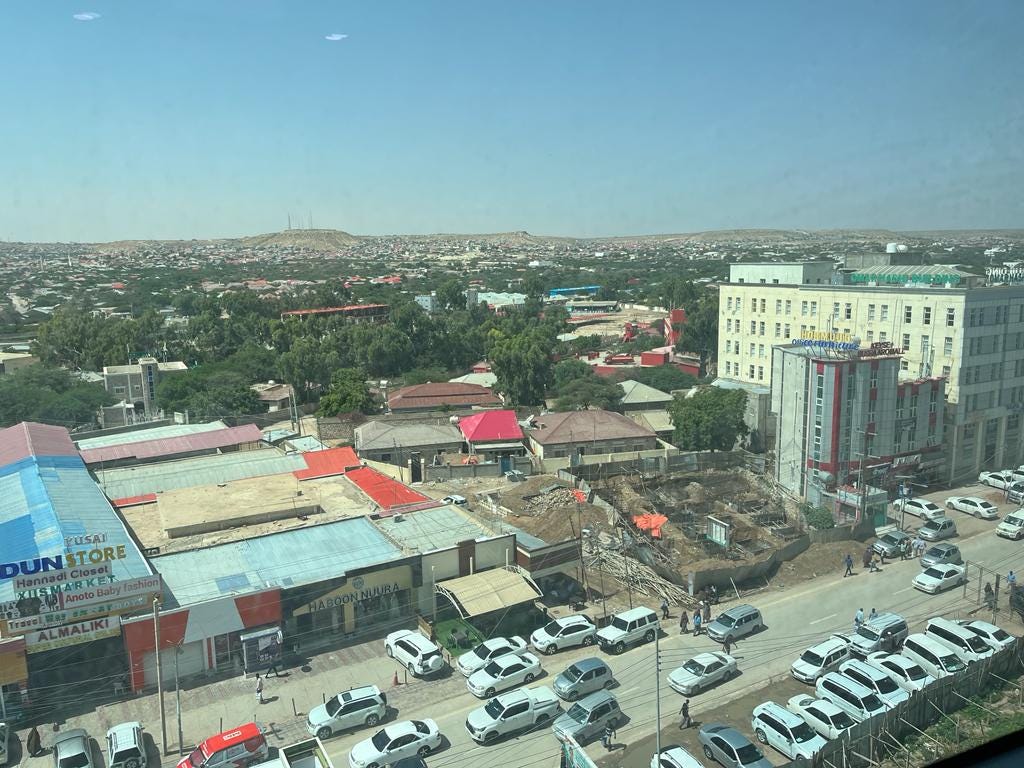In early 2022, my wife and I, a Texan and a New Yorker, decided to leave our tech jobs in San Francisco to move to Somaliland. 
It felt like a natural, even obvious career move for both of us.
She became the president of Barwaaqo University, the country’s first residential women’s university. She was the best candidate for the job. She’d be great at running a university in the US too. But nobody was about to let her do that because she’s 29, and American universities don’t usually put 29-year-olds in charge.
As for me, I came to Somaliland to build a venture capital fund. I could have started a fund in San Francisco, but SF doesn’t really need more VC funds. A fund in Somaliland is more useful, more interesting, and it’s going to produce much better returns. That last part surprises some people.
VC in San Francisco vs. VC in Somaliland
The returns of a VC fund are based on two inputs – entry price and exit price.
If you’re a fund investing in pre-seed companies in the US, the average valuation of a company you invest in is $10M. That’s as of Q3 2022, after a big market downturn.
A pre-seed company in the US typically doesn’t have revenue, a team, or a product. It’s usually just a deck with a founder or founders attached. US investors have decided, on average, that promising founders with an interesting idea are worth $10M.
Most of the time, these companies go to zero. It sounds crazy to make this kind of investment. But it makes sense because sometimes – in around one out of every twenty companies – the two founders with a pitch deck wind up building a huge business. The returns from that one company can be large enough to create a successful portfolio, even if all the other investments went to zero or returned a very small amount of money. Virtually all early-stage VC funds operate on this logic. Most companies will fail, and one or two will succeed in a big way.
Average returns for a VC fund are a little bit less than 2x the size of the fund (typically over a 10-year life of the fund). A very good VC fund returns 3x or more.
When a pre-seed fund in the US invests in a bunch of companies at $10M valuations, their condition for a successful fund is that one of those companies gets acquired or goes public at a valuation north of $1B. (This is oversimplified, but a useful rule of thumb.)
Now let’s compare this to Somaliland.
In Somaliland, instead of valuing a pre-seed company that’s just two founders and a deck at $10M, we value that company at $100,000 or $200,000. (Actually, we sometimes value operating, profitable companies at those valuations.)
Because our entry prices are 50 to 100 times lower than in the US, our exit prices can also be 50 to 100 times lower and still produce the same level of return as the pre-seed fund in the US.
In other words, where a US pre-seed fund needs one of their companies to have a $1B exit for the fund to be successful, we would only need one of our companies to have an exit of $10M or $20M. The second one is much easier!
If one of our companies gets to a $1B exit – or even 20% of that – then our fund is massively successful.
Sidebar – can Somalilanders really build big companies, though?
Yes, they can.
There are multiple billion-dollar businesses that are headquartered in Somaliland or were built by Somalilanders. Just last year, WorldRemit, founded by Somalilander Ismail Ahmed, was valued at $5B.
Thanks to the internet, billion dollar companies are built in every part of the world.

The reality of internet penetration in emerging markets
I think the idea of “internet penetration in emerging markets” feels a little abstract to most people.
One thing it means for founders is that the barriers to entry and scale are rapidly shrinking. The tools and knowledge that management teams need to build their companies are all right there on the internet, and they’re free or very close to it.
It’s also easier to access customers than it’s ever been. Internet platforms enable low-cost distribution and product discoverability, and not just locally. Somalilanders can and do sell products to people all over the world.
For most of our companies, Somaliland will be the first market, and then the company will expand to East Africa (300 million people) and the Gulf States (65 million people, $2.5T in GDP).
Here’s the reality of how Somalilanders use the internet: Everybody is on Facebook. Everybody communicates through WhatsApp, including businesses. Every young person is on Instagram and TikTok.
Maybe you’ve heard about mobile payments in Africa “leapfrogging” wealthy nations?
I’ve lived in Somaliland for more than two years, and every payment I’ve made since the first week I was here has been through my phone. If you have someone’s phone number, you can pay them in 20 seconds, they’ll receive it instantly, and there’s no fee on either side. There are a few beggars on the street, and they ask for money by holding up a cardboard sign with their phone number written on it.
Now combine the way Somalilanders use internet platforms with the ease of mobile payments. Somalilanders are already living in Facebook, Instagram, and WhatsApp. That’s where they’re getting news and entertainment and communicating with friends and family. How much do you think it costs to put an ad on Facebook or Instagram in Somaliland, compared to the US? Once a customer clicks through, they can easily start communicating with the company on WhatsApp, through text, links, images, videos, and voice. When they’re ready to buy, they can pay through their phones like they do with virtually every other transaction in their lives.

VC as sales vs. VC as company-building
Back to how VC is different in SF than Somaliland.
The actual performance of venture capital – excluding the role played by LPs – has four parts.
- Sourcing: when you meet founders who are raising money for their companies and get them to pitch you
- Winning: when you convince a founder to let you invest money in their company
- Picking: when you think about all the companies that you could invest in and decide which ones to actually invest in
- Helping: Once you’ve invested, this is when you actually help the founders build a successful business
The San Francisco Bay Area is lousy with venture capitalists. It’s an oversaturated, very competitive market.
One consequence of that is that the sourcing and winning wind up being disproportionately important. If you’re a Bay Area VC, there are 500 other VCs who invest in the same things you do. Your biggest fear is that they’re seeing companies that you’re not seeing. Your second biggest fear is that when you do see a company that you like, one of the 15 other VCs who saw the company is going to win it away from you.
The more saturated a market is with VCs, the more each VC is incentivized to pour their resources into sourcing and winning – in other words, marketing and sales. The more they focus on sales and marketing, the worse they are at every other part of the business.
The incentives for VCs to focus on sales have gotten so out of control that a lot of VCs are now explicitly ignoring the other parts of the business as a strategy. Why waste time diligencing and helping companies when that only makes it harder to source and win new deals?
Things are different in Somaliland.
There are no other venture capital funds in the country. I hope someday soon there will be, but right now we’re the only one.
Having no competition comes with a lot of advantages.
For one, we don’t have to obsess over sales the way VCs in the US do. We barely have to think about it at all. We just have to hang out our shingle and tell a few well connected people we know, and it’s enough to help us see and win basically every viable VC deal in the country.
We don’t have to waste time and resources worrying about deal access, and we don’t have to rush into investments because we’re afraid of missing out.
Instead, we can spend time getting to know founders, studying their business and their market, and watching them build the company over time. We can make informed investment decisions on our own schedule. And once we invest, we don’t have to scramble back to the sales floor. We can spend time with our portfolio companies, helping them build their teams and scale their businesses.

Geopolitical risk vs. Deal access risk
Fundamentally, we’re playing a different game than other VCs.
Because of our environment, we have massive advantages in access to companies and talent, in deal structure and diligence, and in pricing.
For most VCs, the core risk is deal access.
Our core risk is geopolitical.
At first glance, investing in Somaliland sounds very risky. But that’s because most people don’t know anything about Somaliland. (I certainly didn’t before I first came here in 2017.)
People don’t know that despite its unrecognized status, Somaliland has been democratic and independent since its founding in 1991. It has an independent government, legal system, military, and currency, which is pegged to the dollar. It’s considered by Western observers to be the strongest democracy in East Africa. It’s a stable, investor-friendly nation with strong legal protections and tax incentives for foreign investors.
The fund is partnered with Abaarso Network, an international entity that’s been running Abaarso School, the top educational institution in the country, for a decade and a half. I taught there, and I’m well plugged into the alumni network, which is one of the most talent-dense ecosystems in the country. The fund’s network of advisors includes senior leaders at Somaliland’s leading financial institutions and businesses and influential cultural figures across local communities.
There’s a long list of things we’ve done to feel comfortable in our protections as investors. The most essential is our mission. We’re investing exclusively in Somaliland companies. The only way we can succeed is by helping Somalilanders build huge businesses.
VC that matters vs. VC that doesn’t
Most VCs in the US want to invest in companies that other VCs want to invest in. That’s an essential signal for them.
Andreessen Horowitz GP Alex Rampell explained the rationale for this in a podcast he did last year, and it’s pretty straightforward.
Venture-backed companies in the US are built to grow fast and unprofitably. In the US, 70-80% of companies are unprofitable at the time of IPO.
The way venture-backed companies fuel fast, unprofitable growth is by raising new rounds of venture capital every couple of years. So if you’re an early-stage investor, one of the most important factors in your investment decision is whether you think other VCs will continue to invest in your unprofitable company. That means VC investors are heavily selecting for consensus deals when they make investment decisions.
Consensus companies by definition don’t need more champions, and they’re usually not solving important societal problems. They’re usually enterprise software companies with well known sales motions that can produce predictable recurring revenues.
If we take a step back and look at the incentive structure for a VC in San Francisco, all that you’re left with is “find the deals that everyone wants to do and then win the right to invest in them.” The marginal utility of another VC in this structure is close to zero.
There’s a reason people invest in boring enterprise software companies with predictable revenues. It’s because they’re good businesses! We’re going to invest in those in Somaliland too! And we’ll feel good about it because a) if we don’t invest in and help build them, nobody will, and b) those successful companies will generate wealth, employment, and ecosystem growth that are far more impactful in Somaliland than they would be in San Francisco.
But there are opportunities in Somaliland that go well beyond boring enterprise software. Emerging markets have huge categories that are still untouched. By investing in these spaces, we get to have an enormous positive impact on the country while generating much greater returns than funds in SF.
If you’re interested in what we’re doing…
Email me at jesse@abaarsoventures.org. I’d be happy to share more about what we’re working on!

By Jesse Clain
Source: Jesse Clain blog




























